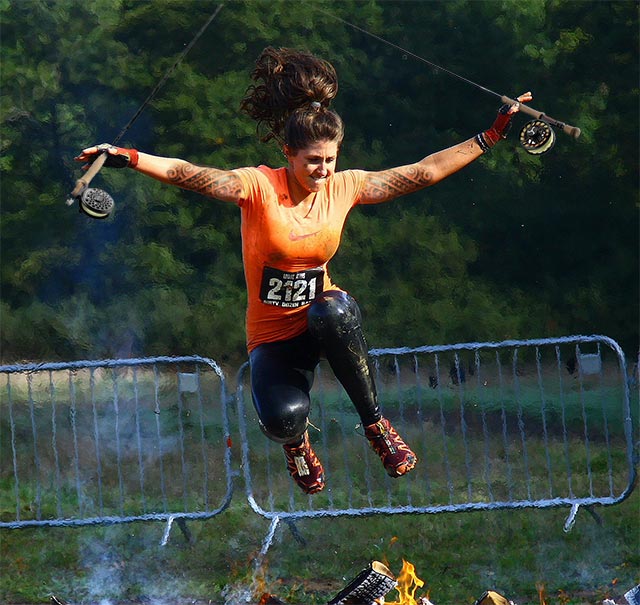Running the Mud, Fly Rods In Hand

Race-organizer Khät Conners practices a fire jump before donning her waders at a 2014 Rough Rod Run. from an image by Funky Dooby
Published April 1, 2015
Not to be out-done by Tough Mudder or the Spartan Race, semi-pro guides (and hot fly-fishing couple of the moment) Khät Connors and Xhonny J started the official Rough Rod Run, or “R3” race, in 2013. Combining natural terrain with artificial obstacles, R3 races require participants to wear chest waders and wading boots and carry two 6-weight fly rods as they make the run. Total time and rod condition at the finish line determine winners. Snap a rod down to the stripping guide and you’re DQ’d.
MidCurrent: You two live together in Portland, Oregon, but fish all over. What was the Eureka moment for Rough Rod Run?
Khät: We were wading Rock Creek, outside Missoula, back in ’10, and Xhonny slipped under a mass of flotsam holding a couple Winston Borons. He totally disappeared in this hole, so I jumped in after him, but stupid me I didn’t let go of the two Winston IM-6’s I was holding. We bumped asses in the spin-out.
Xhonny: The current was holding us down big time. I grabbed Khät’s wader straps and kicked along the bottom until we got out of the spin. When we crawled up on the bank, we both realized we hadn’t broken the rods. We were, like, “Cool. Betcha couldn’t do that again.” So we did, just jumped in, and we did it three more times without breaking a rod.
K: After that, we started doing contests with our friends. You know—shotgun three beers and climb into the tree house with a Paul Young 5-weight without breaking it. Or, take the 15-Belmont bus from 27th Street to Yamhill with a fully assembled 7-foot Sage, no breakage. We started posting videos to YouTube.
MC: After that came the backyard obstacle course?
X: We uber-shared some skater ramps locally and disassembled them, and built the “Supa-Stacle.” Climbing walls. Hurdles. Water hazard. Ropes. The whole thing extended over three backyards, but everyone was into it, so no hassle. We had three competition categories: Sub-5. Tip-Top. Bamboo.
MC: “Sub-5”?
K: Rods under $500. Tip-top is over $500. And bamboo is freakin’ bamboo. Pretty soon we were having sponsored events. Local brew pubs were involved. The Oregon Organic Cannabis Collective threw in. The Pacific-Northwest Yak Breeders Association.
MC: Do you have any endemic sponsors?
X: That is a major-cool area of business development right now. Do we have any rod-makers interested? Yes. Are they offering sponsorship? Not yet. But it’s going to happen. We’re in serious negotiations right now with a Cleveland-based thread maker.
MC: Describe how a Rough Rod Run comes together.
K: Total flash-mob dynamic. We have a database of registered racers. We send out a blast to our team to set up the obstacles, and then a blast goes out to the racers. They have 48 hours to get to the starting line.
MC: Flash mobs are usually much more instantaneous.
X: Yeah, but when you figure people have to cover a lot of ground to set up and get to the course, a 48-hour window is acceptable. We’ve got racers coming from all over the country.
MC: What is a typical R3 course like?
K: O.k., so, first we’ve usually got four artificial obstacles like ramps, walls, or beams, although they’re actually totally natural because they’re made from twice-cycled wood and use only gravity. O.k., then we’ll have two natural obstacles next, like a muddy hill and a small river you have to cross. After that, four more artificials—monkey bars, hurdles, tunnels. And sometimes that includes a dumpster full of compost. Then the final natural obstacle, like a big wooded hill or a small swamp. Then a two-mile run to the finish. So freakin’ bitchin’.
MC: Why a dumpster full of compost?
X: You have to climb in and get out. It simulates both climbing back into a boat you’ve fallen out of, and a mud trap. We’ve all been there.
MC: What happened at the South Fork of the Snake River last year?
X: You’re taking the hater-bait, dude. Because that was a small glitch that got so blown out of proportion. Everything was legal—everything was public access and we had monitors all over the course. O.k., so, there was the part where the racers had to cross the river. We picked a wide spot so it was generally shallow. But what happened was that the yellow sallies came out maybe three or four days early last year, and the local guides had rushed a lot of clients out there to fish. So our racers were crossing paths with the drift boats and a small, small minority of people got pissed. But we really tried to race ahead of that hatch.
MC: What makes the R3 races worth it for you guys and for the competitors?
X: You know, when you’ve got a top competitor, a pro-guide who shows up with two $3,000 bamboo rods, and he’s all-in, you know – he’s been training, he’s got his mouth-hold technique freakin’ perfected – it’s just beautiful to watch someone like that hucking the hurdles, flying through the monkey bars and the swamps, not breaking a rod. That’s Olympian, man.
K: Skills. Mad skills – that’s what comes through, for both the men and women anglers who do the R3. Because they know the next time they go fishing, and they have to climb up and down gnarly river banks or put rods in racks on their vehicle, they know that they won’t break a single rod, cause the race made them that good.
MC: And all those competitors who totally destroy their rods?
X: I think that’s something that’s gonna really interest the manufacturers.











